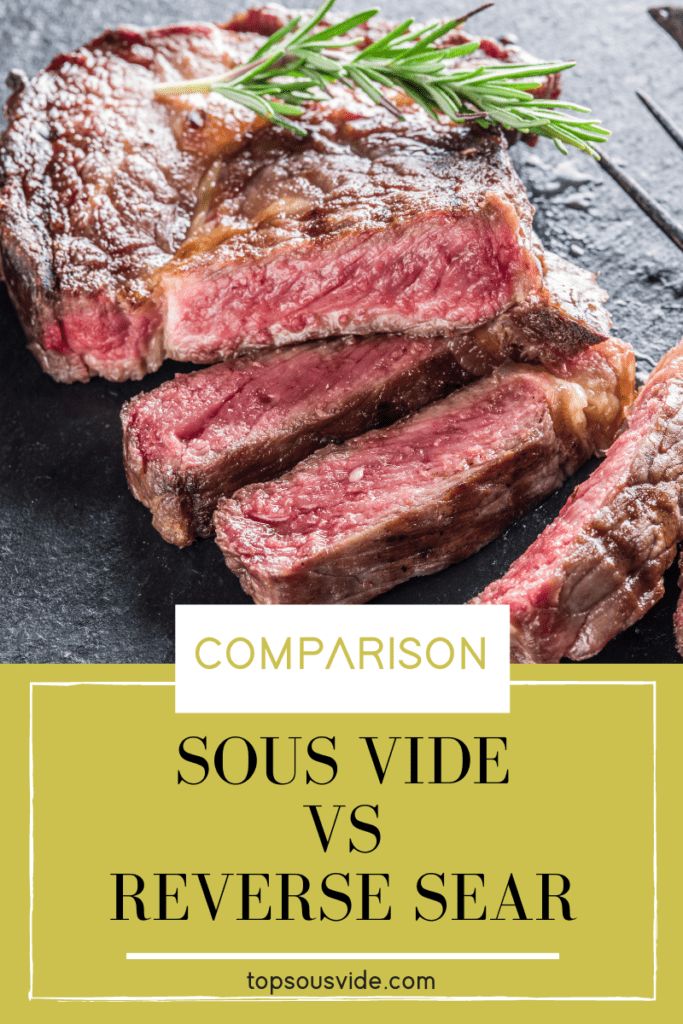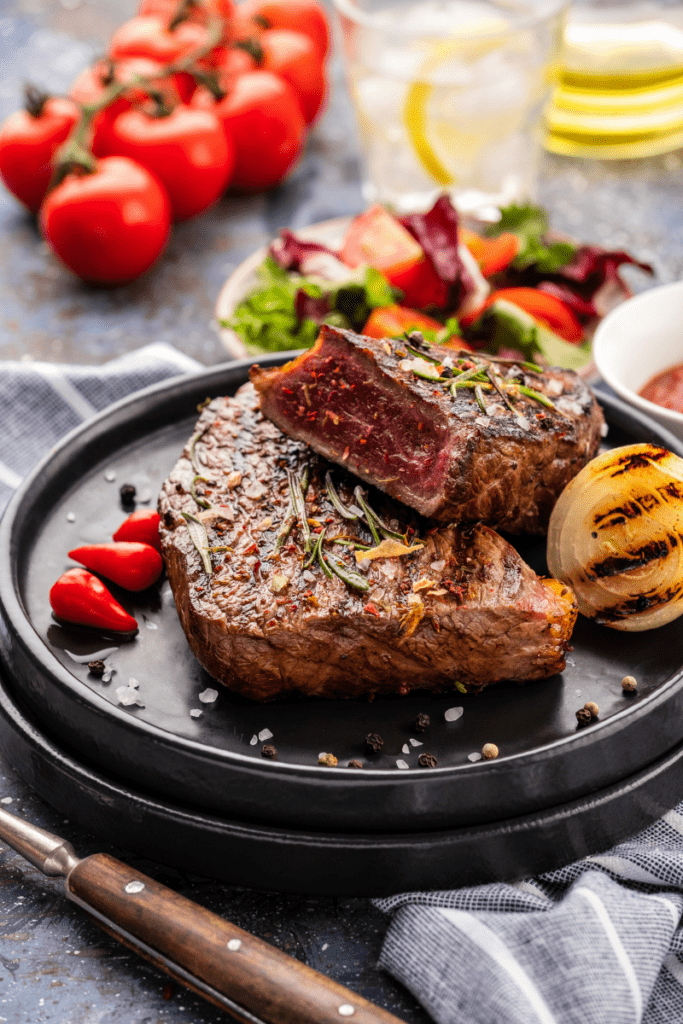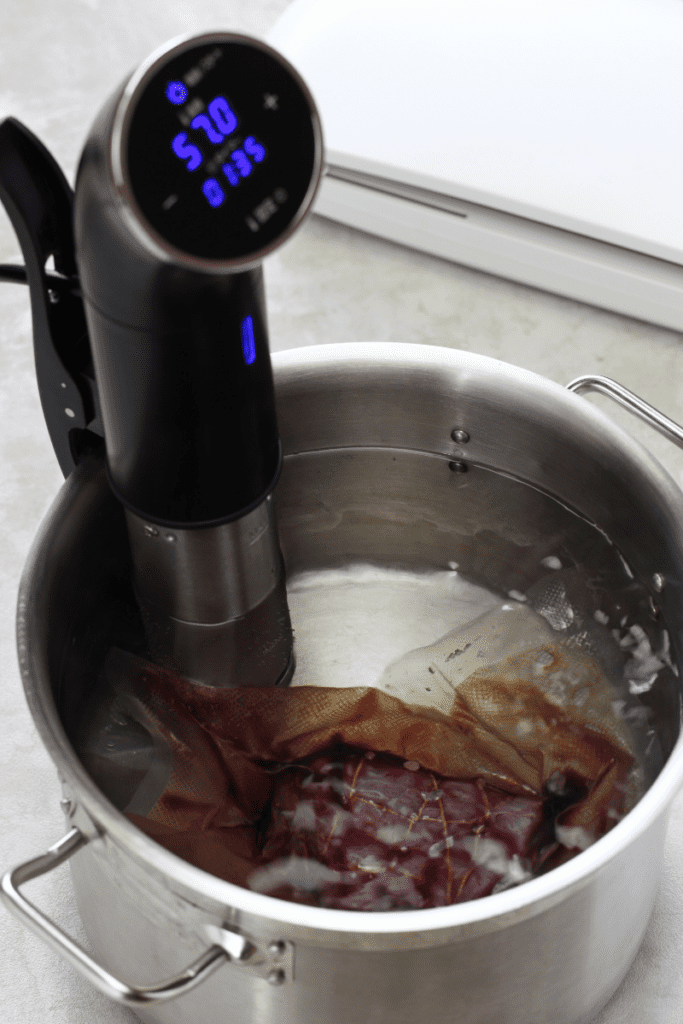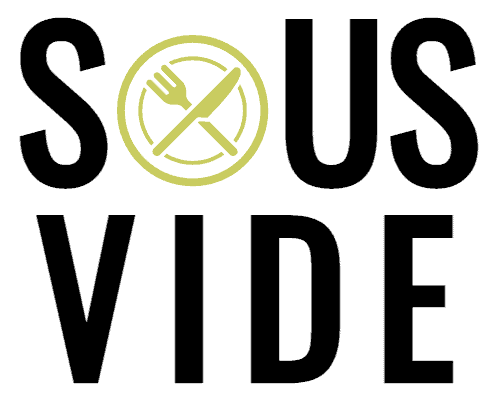If you’re a meat lover, the debate between sous vide cooking vs reverse sear cooking is an important one. They are two entirely different techniques that produce different results with high levels of flavor.
Sous Vide and Reverse Searing are two different approaches to cooking of steaks that have been growing in popularity over the past few years. They’re both cooking techniques that are often used in restaurants.
In this post, I discuss Sous Vide vs Reverse Sear: how they work and the pros and cons of each. Finally, I will have a look at where the methods are similar, and how they differ from each other.
- Related Article: Best Steak Cut for Sous Vide
- Complete Guide to Searing Sous Vide
- Do Restaurants Use Sous Vide

Table of Contents
How Does Reverse Searing Work?
I used to wait tables at a steak house, in a professional kitchen. It always amazed me how the chefs cooked the steaks to perfection time after time.
The common method they used was to “sear” the steak in an extremely hot pan and then place it in the oven until it was the correct doneness.
The reverse sear method, as the name suggests, is the exact opposite of Searing. To reverse sear steaks you will cook the steak slowly on low heat in the oven until the right level of doneness is achieved, only then is the steak seared on a high heat.
This cooking technique is fantastic for producing steaks from medium-rare through to well done. Rare steaks are usually done adequately in a hot pan without the need to reverse sear, although it can be done.
The idea behind reverse searing steaks is the increased control it gives cooks over a process known as the Maillard Reaction. This is the name given to the browning reaction that gives seared/browned food much of its flavor.
When you see a steak being served and the cooked edges look browned and delicious, you can thank the Maillard Reaction and food science.

To be absolutely precise with the doneness of the meat, it is better to start the searing process just before the steak has reached the desired temperature.
A general temperature guide is below. To achieve that perfect steak sear, sear the steak when the meat is a few degrees below your desired temperature.
- Rare – 125° F
- Medium Rare – 130° F
- Medium – 140° F
- Well Done – 160° F
Reverse Searing Benefits
- Control over the finish – Because you sear right at the end of the cooking process, you can sear the steak just as you like it and know it won’t be altered in the oven.
- Precision – It is easy to cook steaks just the way you like them.
- Color – Searing a steak then placing it in an oven, accounts for that gray band of color just inside the meat. Cooking it gently and evenly first means the pinkness is retained from edge to edge.
- Sears more easily – Because much of the moisture that can slow the searing process down is removed in the cooking process, steaks sear easier and quicker.
Reverse Searing Cons
- Time – Reverse searing steaks takes considerably longer due to the initial “slow cooking” phase.
- Thinner steaks don’t reverse sear well – To work best, you should get a thick steak to reverse sear. Ideally steaks should be at least 1.5 inches (3.81 cm) thick.
- Harder to make a glaze – Searing at the end of the cooking process doesn’t leave a “frond” behind. Frond are the brown bits that stick to the pan after searing, many cooks like to use this to make a glaze.
How Does Sous Vide Work?

Sous Vide is a low-temperature cooking process in a water bath. Sous Vide translates to “under vacuum” from French and this is the other aspect that defines Sous Vide as a method.
In Sous Vide, you’ll season you steak and then vacuum seal it in a vacuum bag. Once it’s sealed, it’s immersed in a container of water to cook using a sous vide machine.
The sous vide process uses the temperature of the water bath to control the doneness of the steak and offers a precision that other methods struggle to achieve.
Although times can vary depending on the thickness of the steak, the table below is a guide to how to Sous Vide a steak to perfection.
| Doneness | Temperature | Time |
| Medium Rare | 129° – 134° F | 1 to 4 hrs |
| Medium | 135° – 144° F | 1 to 4 hrs |
| Medium Well | 145° – 155° F | 1 to 3.5hrs |
| Well Done | 156° + | 1 to 3hrs |
A noticeable absence from the list is for a rare steak, once again this isn’t a method that lends itself to cooking rare steaks.
The method is renowned for producing tender steaks that melt in the mouth. The slow cooking process slowly melts the meat’s natural fats and these saturate the steak giving it an intense flavor.
The flavor is also intensified by the meat being contained in a vacuum throughout the cooking time, this means that no goodness or flavor evaporates as it cooks.
After cooking sous vide, the best way to seal in the juices and to get that beautiful finish is to sear it. You can do a quick sear on all sides of the steak in a cast iron skillet to get that delicious crust to lock in the steak juice. Another option is to put the steak on a hot grill (a gas grill or charcoal grill both work great) if you prefer that. You can also torch it!
Just be sure to remove the surface moisture first before searing by patting it dry with paper towels. The drier the better! You don’t want to create a ton of steam or have water splatter at you when you go to sear your steak.
Sous Vide Benefits
- Consistent Results – Because the temperatures and timing are precisely controlled, steaks are cooked to perfection time after time.
- Healthy – Fewer fats and oils are used in the cooking process, also fewer nutrients are lost during cooking.
- Convenient – Cook steak to perfection well in advance then add that final sear right at the end… Perfect to impress guests at a dinner party
- Flavor – All that goodness is sealed in a plastic bag and the steak cooks in its own juices. The results are an amazingly good steak that is succulent, tender, juicy, and crammed full of flavor.
See the top sous vide health benefits.
Sous Vide Cons
- Slow Cook Time – This isn’t a last-minute dish, as you can see from the table above, cooking times can run into several hours.
- Requires Additional Equipment – Water temperature accuracy can only be achieved by using a Sous Vide cooker, these come in a variety of types including immersion circulators, standalone water ovens, and some smart precision ovens.
- Flavors can be too enhanced – If you like a hint of garlic with your steak be careful! Because all the flavors are sealed in, it is easy to overpower your steak with flavorings
Read more about the best sous vide machines in my other post.
Similarities and Differences
Sous Vide and Reverse Searing Similarities
Both these methods use a similar approach to cooking steak. Sous vide and reverse sear both have a searing component, and they also both have the ability to “reverse” cooking results. That is, with sous vide, you cook first in a water bath then sear after, so that you don’t lose any juices.
Both cook the meat slower than with traditional methods. This allows the steak to cook more evenly and results in a succulent and tender meat that you can slice through with a butter knife.
If you like a seared steak, then both these methods can be used to produce the same end result, with the only difference being the cooking method used to get them to the desired doneness first.
Sous Vide and Reverse Searing Differences
As I noted, both use a “slow approach” to cooking steaks. But the way that the steak is cooked slowly is the fundamental difference between the methods.
At its heart, Reverse Searing is still traditional cooking, with traditional equipment, only the order of the cooking process is reversed.
Sous Vide requires additional equipment and a little more time. It also doesn’t expose the meat to the elements until it is ready to sear (if searing is required).
Finally, although both rely cooking at a precise temperature, it’s much harder to precisely control the temperature in an oven. That means you’ll need to monitor the steak inside the oven throughout the cooking process to make sure the steak isn’t overcooked or undercooked.
Sous Vide vs Reverse Sear FAQ
Both are great options and a bit of this is about your own personal preference. The sous vide method is an easy way to get a perfect steak every time while a steak that’s cooked using reverse sear take a bit more attention but will yield an amazing steak.
The best benefit of a reverse sear is the control you have. You’re cooking at a much lower temperatures for longer so the chances of overcooking your steak is much lower.
Yes, it’s best to sear your steak on a seasoned cast iron skillet after you sous vide it to create that delicious crust to lock in the steak juice.
Final Thoughts on Sous Vide vs Reverse Sear
Sous vide and reverse searing are two methods of cooking steaks that many fans have added into their cooking repertoire.
Both Sous Vide and Reverse Searing consistently produce mouthwatering, tender steaks, that are bursting with flavor and taste.
I do prefer the sous vide method myself as it’s easier to control the internal temperature of all pieces of meat using a sous vide cooker than an oven.
For more comparison of sous vide and other cooking techniques, check these articles out:
